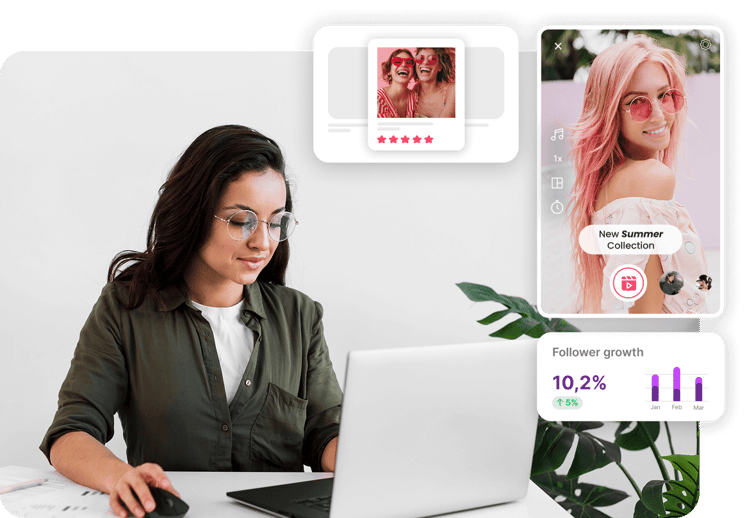The impact of user-generated content (UGC) on TikTok
With millions of daily active users, TikTok has become a space where people can create, share and discover a wide variety of content. User-generated...
Plan, activate and control media to hit targets with precision.
Turn data into smart decisions with advanced analytics and modeling.
Efficiency, governance and scale for agencies and teams.

[Ebook] How to plan for an unstoppable peak season
Master high seasons with strategy, data, and automation. Discover how to optimize your campaigns during peak demand periods with strategies based on market analysis and consumer behavior.
Discover more
For years, brands have chased “authentic” content as if it were hidden treasure. We went from glossy ads to vertical video, from the studio to the mobile phone, from models to everyday people showing everyday things.
Every time we open TikTok, Instagram or any short-form video platform, we see the same scene repeated in different versions: someone, without lights or a studio, showing how they use a product, sharing an opinion naturally or teaching a trick you “didn’t know you needed”.
Sometimes it’s an anonymous creator, other times it’s a well-known profile.
It always looks spontaneous.
It never completely is.
UGC has become the most brutal laboratory that exists today to understand what activates your audience, what blocks their purchase decision, which angles work and which ones die after three seconds.
And in parallel, influencers have stopped being simply “accounts with millions of followers” to become cultural curators, key pieces to generate credibility and, above all, signals of trust that algorithms are increasingly taking into account.
The problem is that many brands still throw everything into the same bucket:
UGC, influencers, creators… as if they were interchangeable. They aren’t.
And when you use them the same way, you lose the only thing that makes them work: their difference.
The key is not choosing one over the other.
The key is understanding what each one brings and how to turn both into actionable learning.
TABLE OF CONTENTS
An UGC video doesn’t need a familiar face, a studio or an epic storytelling. It needs something much harder to manufacture: naturalness that doesn’t distract.
UGC works because it:
But its real value isn’t in the video. It’s in what the video allows you to learn.
Behind every UGC piece there are signals you can measure:
A UGC creator doesn’t sell you their fame. They sell you variations, and those variations are data.
The more pieces you have, the more signals you get.
The more signals you get, the more creative intelligence you build.
The more intelligence you build, the better decisions you make.
In fact, the evolution of formats on social platforms shows that this type of content not only grabs attention but also keeps it, and that explains why in certain environments, especially highly visual verticals, UGC has shown a disproportionate impact on discovery, conversion and formats.

Influencers have evolved a lot. Most brands still see them as “someone who gives us reach”, but that’s already outdated.
Today an influencer brings: social proof, a distinct voice, topical authority, emotional affinity, communities that actually listen.
An influencer doesn’t tell you “this is how you use this product”.
They tell you “this fits who you are”.
That doesn’t optimise CTR. That shapes brand perception, something no algorithm can force if the audience doesn’t feel it.
The common mistake is asking an influencer for direct performance when their strength lies elsewhere: making people trust, understand and care.
While UGC optimises, influencers contextualise. They don’t stand out for showing the product (that’s what UGC is for), but for something more intangible and valuable: credibility. If UGC feeds the algorithm, the influencer feeds the user.
And here’s something many brands overlook: micro-influencers, precisely because they’re not celebrities, generate a much more organic and persuasive type of impact, especially when it comes to triggering decisions.

When a mature brand understands this, it stops asking an influencer to “do something UGC-style”, and stops asking a UGC creator to “do content in your influencer style”.
Each one plays a very different role:
The magic happens when they work together:
The brand stops being just a message and becomes a system.
|
Aspect |
UGC Creator |
Influencer |
|
Need for followers |
No |
Yes, their value depends on the audience |
|
Cost |
Low / medium |
Medium / high |
|
Production speed |
High (several pieces per week) |
Medium (schedules, negotiations, personal style) |
|
Main role |
Creative testing + performance |
Credibility + reach + positioning |
|
Most common formats |
Reviews, demos, POV, unboxings, comparisons |
Storytelling, lifestyle, recommendations, aspirational content |
|
Ideal for… |
Variations, scaling in paid, feeding AI |
Awareness, trust, brand perception shifts |
|
Type of data they generate |
Creative and efficiency signals |
Engagement, affinity and authority signals |
|
Dependence on the algorithm |
Low (it’s the ad that matters) |
High (depends on organic visibility) |
Here’s the secret almost no one talks about: it’s not about producing more content, it’s about producing content that generates signals.
When you analyse UGC and influencers from the right angle, you see things like:
And suddenly, content stops being a bet
and becomes a scientific tool.

When you look at UGC and influencers as sources of signals, you get:
1. Creative data
Which narrative, pace, tone or style works best by platform.
2. Strategic data
Which values resonate and how brand perception changes.
3. Operational data
Which pieces support each stage of the funnel best, and which ones you should scale, pause or replicate.
This turns creativity into a continuous optimisation engine instead of a guessing exercise.
Real performance appears when you combine both worlds:
UGC without influencers → performance without brand.
Influencers without UGC → brand without actionability.
Both together → a creative system that learns and scales.
2025 isn’t about creativity vs performance.
It’s about how you use creativity to generate performance, and how you use performance data to improve your creativity.
UGC and influencers are part of the same game, but they follow different rules.
UGC tells you what works.
The influencer tells you why it matters.
Data tells you how to repeat it.
AI tells you how to scale it.
And if you do it well, your brand stops relying on creative luck
and starts operating like an intelligent system.

With millions of daily active users, TikTok has become a space where people can create, share and discover a wide variety of content. User-generated...

Brands no longer have absolute control over the conversation. Today, the people who truly grow a brand are its customers—the ones who share, comment,...

For more than a decade, social media strategies have relied on a mantra repeated ad nauseam: always be present. The reasoning seemed logical: if you...